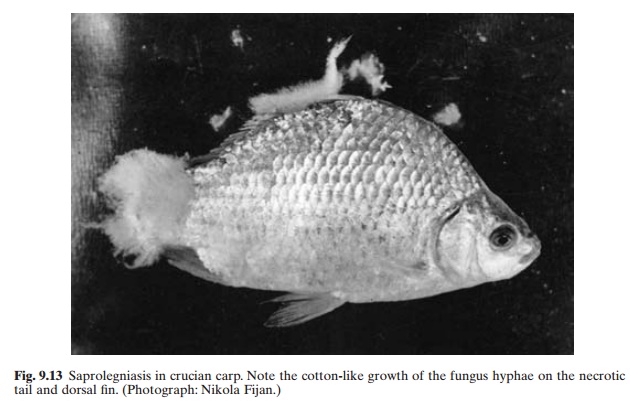Chapter: Aquaculture Principles and Practices: Health and Diseases
Saprolegniasis - Fungus diseases of aquaculture species
Saprolegniasis
Saprolegniasis is a disease affecting the skin and gills of fresh-water fish and crustaceans caused by Saprolegnia and a number of non-saprolegniaceous fungii, including Pythium and Leptomitus. The three major species of Saprolegnia associated with the disease are S. ferax,
S. parasitica and S. diclina. They can be identified by the characteristic profusely branched, non-septate, cotton-wool-like tufts of mycelium (fig. 9.13). They reproduce asexually by means of biflagellate spores.

Environmental stress, overcrowding, poor handling and weakness caused by bacterial and viral infections appear to be the factors that make animals susceptible to saprolegniasis.
Temperature appears to have a major role; in temperate climates epizootics occur at low temperatures, whereas in the tropics they occur in high-temperature conditions.
Lesions appear as grey-white patches on the skin, fins, eyes, mouth and gills. The colour may change to dark grey or brown as the mycelium tangle and trap debris. The mycelium invades the uppermost layer of the dermis and then ramifies laterally, eroding the epidermis. Affected eggs may be completely covered by the fungus.
Control of the disease should obviously start with avoidance of primary causes like bad handling, injuries, poor sanitation and water quality, and weakness of the animals. A suggested curative treatment for fish consists of baths of (i) potassium permanganate (1 g per 100 litres water for 60–90 minutes), (ii) common salt (10 g per litre of water for 20 minutes for young fish and 25 g per litre of water for 10 minutes for older fish), (iii) copper sulphate (5 g per 10 litres of water until the fish show signs of stress), and (iv) malachite green (67 ppm dip for 10–30 seconds).
Incubating eggs may be given a daily formalin bath for 15 minutes (1–2 ml 30 per cent formol for each litre of water fed into the incubator). Malachite green can be used at concentrations of 5 mg per litre or 1 g for 200 litres of water for half to one hour. A concentration of 5 g/m3 for 45 minutes, repeated every five or six days, has also been suggested. There are differences of opinion regarding the use of malachite green, as it is suspected that its use on trout eggs may result in genetic defects.
Related Topics